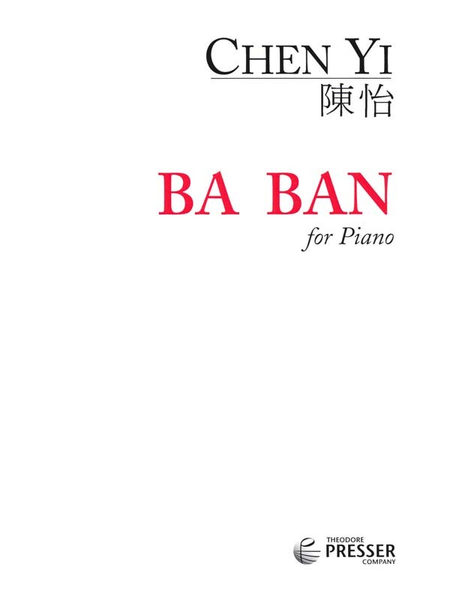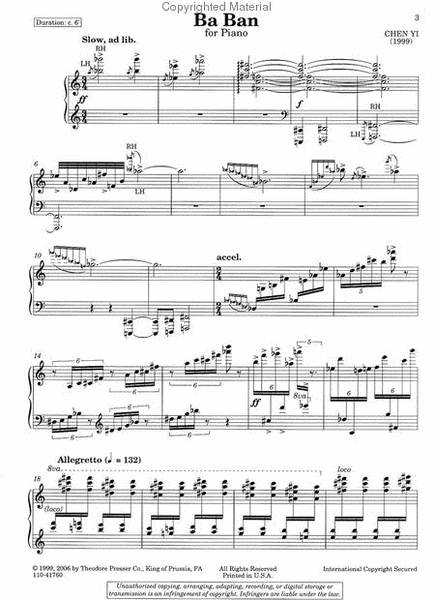Ba Ban
for Piano
-
Ships in 1 to 2 weeks
Details
Description
SKU: PR.110417600
For Piano. Composed by Chen Yi. Solo part. With Standard notation. Composed 1999. Duration 6 minutes. Theodore Presser Company #110-41760. Published by Theodore Presser Company (PR.110417600).UPC: 680160490370.
Chen Yi is celebrated for her music bridge between ancient Chinese folk music and our modern Western compositional styles. In Ba Ban, she reaches back through the centuries for inspiration, creating a challenging concert work for advanced pianists with a distinctive Eastern environment. The basic material for Ba Ban is drawn from the popular Chinese traditional instrumental piece “Ba Ban” and from Chen's own Piano Concerto, which is entirely based on the form, rhythmic organization, and pitch material of the original folk tune. General impressions of the style of Chinese mountain song singing and Chinese instrumental playing also influence the sounds that are heard in the textures of the piece.
The basic material for Ba Ban is drawn from the popular Chinese traditional instrumental piece, “Ba Ban,” and from my own Piano Concerto, which is entirely based on the form, rhythmic organization, and pitch material of the original folk tune. General impressions of the style of Chinese mountain song singing and Chinese instrumental playing also influence the sounds that are heard in the textures of the piece.Most Chinese folk solo pieces have a single theme each, with sectional developments in different speeds and performing techniques, with added decorations on the important notes from the melody. This inspired me to construct my piano solo piece in four sections, starting with the theme in the initial seven-measure phrase, which is based on the pitch material of the first phrase of the Chinese folk tune “Ba Ban” (Eight Beats): B(, B(, E(, A(, G(; D(, E(, G(; E(, G(, G(, B(, A(. The first section ends at measure 48, where the first transition comes in with a dreamy texture in contrast, bringing the music to the second section (first variation), starting at measure 64. The third section (second variation) begins at measure 98 and goes on to measure 112. The fourth section is anew variation of the theme. It starts at measure 157, with a dramatic cadenza-like texture leading to a strong octave passage. This is followed by the climax—a big burst in the extreme low register (measure 184). The little soft coda starts on measure 233. It carries all the motivic and rhythmic materials, covering the whole keyboard and flying away into the distance.Besides the pentatonic “Ba Ban” pitch material, I have also applied two other pitch materials and woven them with the “Ba Ban” theme into a whole. One is a 12-tone row (B, F, C#, D, F#, G#, A, D#, E, B(, G, C), the other is an ascending five-note motive (B(, C, C#, F#, A). All of them are used horizontally and vertically in primary or transposed forms, sometimes simultaneously in a phrase.The folk tune “Ba Ban” consists of eight phrases, each phrase containing eight beats, except the fifth phrase that has an additional four beats, where the golden section falls in the middle. The rhythmic grouping of the original “Ba Ban” is read as 3 + 2 + 3, 3 + 2 + 3, 4 + 4, 3 + 2 + 3, 3 + 2 + 3 +2 + 2, 4 + 4, 5 + 3, 4 + 4. It is completely presented at the highest end of the keyboard in the coda.


 Share
Share